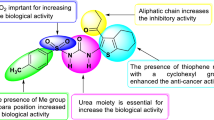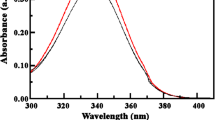Abstract
Liver cancer is the fifth most common cancer and is still one of the leading causes of death world wide, due to food additives, alcohol, fungal toxins, air, toxic industrial chemicals, and water pollutants. Chemopreventive drugs play a potential role in liver cancer treatment. Obviously in the production of anticancer drugs, the factors like poor solubility, bioavailability, biocompatibility, limited chemical stability, large amount of dose etc., plays a major role. Against this backdrop, the idea of designing the chemopreventive nature of bio flavanoid hesperetin (HP) drug conjugated with pegylated gold nanoparticles to increasing the solubility, improve bioavailability and enhance the targeting capabilities of the drug during diethylnitrosamine (DEN) induced liver cancer in male wistar albino rats. The dose fixation studies and the toxicity of pure HP and HP conjugated gold nanoparticles (Au-mPEG(5000)-S-HP) were analysed. After concluded the dose fixation and toxicity studies the experimental design were segregated in six groups for the anticancer analysis of DEN induced HCC for 16 weeks. After the experimental period the body weight, relative liver weight, number of nodules and size of nodules, the levels of tumor markers like CEA, AFP and the level of lipid peroxidation, lipid hydroperoxides and the activities of antioxidant enzymes were assessed. The administration of DEN to rats resulted in increased relative liver weight and serum marker enzymes aspartate transaminase, alanine transaminase, alkaline phosphatase, lactate dehydrogenase, and gamma glutamyl transpeptidase. The levels of lipid peroxides elevated (in both serum and tissue) with subsequent decrease in the final body weight and tissue antioxidants like superoxide dismutase, catalase, reduced glutathione, glutathione peroxidise, and glutathione reductase. HP supplementation (20 mg/kg b.wt) significantly attenuated these alterations, thereby showing potent anticancer effect in liver cancer and the HP loaded gold nanoparticels (Au-mPEG(5000)-S-HP) treated animals shows the better treatment than the pure HP due to the solubility of drug, bioavailability and the target drug delivery of the biodegradable polymer. Histological observations were also carried out, which added supports to the chemopreventive action of the pure HP and HP loaded gold nanoparticles (Au-mPEG(5000)-S-HP) against DEN induction during liver cancer progression. These findings suggest that HP loaded gold nanoparticels (Au-mPEG(5000)-S-HP) shows better efficacy than the pure HP against lipid peroxidation, hepatic cell damage and protects the antioxidant system in DEN induced hepatocellular carcinogenesis.










Similar content being viewed by others
References
El-Serag HB, Rudolph KL. Hepatocellular carcinoma: epidemiology and molecular carcinogenesis. Gastroenterology. 2007;132:2557–76.
Harsh M. Text book of pathology. 5th ed. New Delhi: Anshan Publishers; 2005.
Fattovich G, Stroffolini T, Zagni I, Donato F. Hepatocellular carcinoma in cirrhosis: incidence and risk factors. Gastroenterology. 2004;127:35–50.
Sullivan BP, Meyer TJ, Stershic MT, Keefer LK. Acceleration of N-nitrosation reactions electrophiles. IARC Sci Publ. 1991;105:370–4.
Yadav AS, Bhatnagar D. Chemo-preventive effect of star anise in N-nitrosodiethylamine initiated and phenobarbital promoted hepatocarcinogenesis. Chem Biol Interact. 2007;169:207–14.
Barbisan LF, Miyamoto M, Scolastici C, Salvadori DMF, Ribeiro LR, Eira AF, de Camargo JLV. Influence of aqueous extract of Agaricus blazei on rat liver toxicity induced by different doses of diethylnitrosamine. J Ethanopharmacol. 2002;83:25–32.
Kapadia GJ, Azuine MA, Takayasu J, Konoshima T, Takasaki M, Nishino H, Tokuda H. Inhibition of Epstein-Barr virus early antigen activation promoted by 12-O-tetradecanoylphorbol-13-acetate by the non-steroidal anti-inflammatorydrugs. Cancer Lett. 2006;161:221–9.
Jayakumar S, Madankumar A, Asokkumar S, Raghunandhakumar S, Gokuladhas K, Kamaraj S, Divya MG, Devaki T. Potential preventive effect of carvacrol against diethynitrosamine induced hepatocellular carcinoma in rats. Mol Cell Biochem. 2011;360:51–60.
Wattenberg LW. Inhibition of carcinogenesis by minor dietary constituents. Cancer Res. 1992;52:2085s–91s.
Formica JV, Regelson W. Review of the biology of quercetin and related bioflavonoids. Food Chem Toxicol. 1995;33:1061–80.
Wilcox LJ, Borradaile NM, Huff MW. Antiatherogenic properties of naringenin, a citrus flavonoid. Cardiovasc Drug Rev. 1999;17:160–78.
Karkabounas S, Sofis G, Evangelou A. Implication of free radicals in platelet aggregation: antiplatelet effects of free radical scavengers ex vivo. Epith Klin Farmacol Farmakokin. 1996;10:84–91.
Horvathova E, Sramkova M, Labaj J, Slamenova D. Study of cytotoxic, genotoxic and DNA protective effects of selected plant volatiles on human cells cultured in vitro. Neuro Endocrinol Lett. 2006;27:44–7.
Kanaze FI, Kokkalou E, Niopas I, Georgarakis M, Stergiou A, Bikiaris D. Dissolution enhancement of flavonoids by solid dispersion in PVP and PEG matrixes: a comparative study. J Appl Polym Sci. 2006;102:460–71.
Wang J, Zhou N, Zhu Z, Huang J, Li G. Detection of flavonoids and assay for their antioxidant activity based on enlargement of gold nanoparticles. Anal Bioanal Chem. 2007;388:1199–205.
Paciotti GF, Kingston DGI, Tamarkin L. Colloidal gold nanoparticles: a novel nanoparticle platform for developing multifunctional tumor-targeted drug delivery vectors. Drug Dev Res. 2006;67:47–54.
Gokuladhas K, Jayakumar S, Madankumar A, Rajan B, Elamaran R, Pramila S, Devaki T. Synthesis and characterization of biocompatible gold nanoparticles stabilized with hydrophilic polymer coated hesperetin drug for sustained drug delivery to treat hepatocellular carcinoma- derived cancer cells. Int J Pharm Res. 2014;8(2):98–105.
King J. The transferase-alanine and aspartate transaminase. In: King J, editor. Practical clinical enzymology. London: D Van Nostrand Company Ltd; 1965. p. 121–38.
King J. The dehydrogenases or oxidoreductase-lactate dehydrogenase. In: King J, editor. Practical clinical enzymology. London: D Van Nostrand Company Ltd; 1965. p. 83–93.
Rosalki SB, Rau D. Serum gamma-glutamyl transpeptidase activity in alcoholism. Clin Chim Acta. 1972;39:41–7.
Misra HP, Fridovich I. The role of superoxide anion in the autooxidation of epinephrine and a simple assay for superoxide dismutase. J Biol Chem. 1972;247:3170–5.
Sinha AK. Colorimetric assay of catalase. Anal Biochem. 1972;47:380–95.
Moron MS, Depierre JW, Mannervik B. Levels of glutathione, glutathione reductase and glutathione-S-transferase activities in rat lung and liver. Biochem Biophys Acta. 1979;582:67–78.
Ohkawa H, Ohishi N, Yagi K. Assay for lipid peroxides in animal tissues by thiobarbituric acid reaction. Anal Biochem. 1979;95:351–8.
Keith C, Jamison DVM, George A, Padgett DVM, Thomas G, Bell DVM. Studies of adenine nucleotide biochemistry in the chediak–higashi syndrome. Exp Mol Pathol. 1993;58:40–52.
Bonting SL. In: Bittar EE, editor. Membranes and ion transport. London: Willey; 1970. p. 257.
Ohnishi T, Suzuki T, Suzuki Y, Ozawa K. A comparative study of plasma membrane Mg2+ ATPase activities in normal, regenerating and malignant cells. Biochim Biophys Acta. 1982;684:67–74.
Hjerten S, Pan H. Purification and characterization of two forms of a low affinity Ca2+ ATPase from erythrocyte membranes. Biochim Biophys Acta. 1983;728:281–8.
King J. The dehydrogenase of oxidoreductase-lactodehydrogenase. In: King JC, editor. Pratical clinical enzymology. New Jersey: van Nostrand Company; 1965. p. 263.
Reed LJ, Mukherjee BB. α-Ketoglutrate dehydrogenase complex from Esherchia coli. Methods Enzymol. 1969;13:55–61.
Slater EC, Bonner WD. Effect fluoride on succinate oxidase system. Biochem J. 1952;52:185–96.
Mehler AH, Kornberg A, Grisolia S, Ochoa S. The enzymatic mechanism of oxidation reductions between malate or isocitrate or pyruvate. J Biol Chem. 1948;174:961–77.
Minakami S, Ringer RL, Singer TJP. Studies on respiratory chain linked dihdrodiphosphopyridine nucleotide dehydrogenase. J Biol Chem. 1962;237:569–76.
Pearl W, Cancercao J, Zweifach BW. Microdetermination of cytochrome oxidase in rat tissues by the oxidation of N-phenyl-p-phenylene diamine of ascorbic acid. J Histochem Cytochem. 1963;11:102–4.
Kim JY, Jung KJ, Choi JS, Chong HY. Hesperetin: potent antioxidant against peroxynitrite. Free Radic Res. 2004;38:761–9.
Garg A, Garg S, Zaneveld LJD, Singla AK. Chemistry and pharmacology of the citrus bioflavonoid hesperidin. Phytother Res. 2001;15:655–69.
Aranganathan S, Nalini N. Efficacy of the potential chemopreventive agent, Hesperetin (citrus flavanone), on 1, 2-dimethylhydrazine induced colon carcinogenesis. Food Chem Toxicol. 2009;47:2594–600.
Yalkowsky SH. Techniques of solubilization of drugs. New York: Marcel Dekker; 1981.
Shibayama T, Ueoka H, Nishii K. Complementary roles of pro-gastrin-releasing peptide (ProGRP) and neuron specific enolase (NSE) in diagnosis and prognosis of small-cell lung cancer (SCLC). Lung Cancer. 2001;32:61–9.
Banker DD. Viral hepatits IV. Indian J Med Sci. 2003;57:511–7.
Gey KF. Prospects for the prevention of free radicals disease, regarding cancer and cardiovascular disease. Br Med Bull. 1993;49:679–99.
Whittby LG, Perey-Robb IW, Smith AT. Enzymes tests indiagnosis. 3rd ed., lecture notes in clinical chemistryLondon: Black Well Scientific Publications; 1984. p. 138–69.
Hirose M, Imaida K, Tamano S. Cancer chemoprevention by antioxidants. In: Ho CT, editor. Food phytochemicals: teas, spices and herbs. Washington: American Chemical Society Press; 1994. p. 122–32.
Sun Y. Free radicals, antioxidant enzymes, and carcinogenesis. Free Radic Biol Med. 1990;8:583–99.
Gutteridge JM. Antioxidants, nutritional supplement and life threatening diseases. Br J Biomed Sci. 1994;51:288–95.
Rajeshkumar NV, Ramadasan K. Modulation of carcinogenic response and antioxidant enzymes of rats administered with 1, 2-dimethylhydrazine by Picroliv. Cancer Lett. 2003;191:137–43.
Ramakrishnan G, Augustine TA, Jagan S, Vinodkumar R, Devaki T. Effect of silymarin on N-Nitrosodiethylamine induced hepatocarcinogenesis in rats. Exp Oncol. 2007;29:39–44.
Haridas V, Higuchi M, Jayatilake GS, Bailey D, Mujoo K, Blake ME, Arntzen CJ, Gutterman JU. Avicins: triterpenoid saponins from Acacia victoriae (Bentham) induce apoptosis by mitochondrial perturbation. PNAS USA. 2001;98:5821–6.
Vanisree AJ, Shyamala Devi CS. Status of lipid peroxidation and antioxidant enzymes in malignant (bronchogenic carcinoma) and non-malignant pleural effusions. Indian J Cancer. 1999;36:127–34.
Singh RP, Banerjee S, Kumar PVS, Raveesha KA, Rao AR. Tinospora cordifolia induces enzymes of carcinogen drug metabolism and antioxidant system, and inhibits lipid peroxidation in mice. Phytomedicine. 2006;13:74–84.
Sumathi R, Baskaran G, Varalakshmi P. Effect of DL-lipoic acid on tissue redox state in acute cadmium-challenged tissues. J Nutr Biochem. 1996;7:85–92.
Jesberger JA, Richardson JS. Oxygen free radicals and brain dysfunction. Int J Neurosci. 1991;57:1–17.
Venkatraman M, Konga D, Peramaiyan R, Ganapathy E, Dhanapal S. Reduction of mitochondrial oxidative damage and improved mitochondrial efficiency by administration of crocetin against benzo[a]pyrene induced experimental animals. Biol Pharm Bull. 2008;31:1639–45.
Acknowledgments
The author K. Gokuladhas thanks Indian Council of Medical Research, New Delhi, India, for the financial support provided in the form of Senior Research Fellowship (SRF-3/2/2/156/2011/NCD-III).
Author information
Authors and Affiliations
Corresponding author
Ethics declarations
Conflict of interest
We are relevantly related to the work in this manuscript. We have no relationship, or any other financial source and this manuscript has not been published in any other publication.
Informed consent
The purpose of this work is to produce a new effective nanotechnology based chemotherapy treatment and ensure the better prevention from liver cancer.
Research involving Human Participants and/or Animals
This work is fully relevant to the animal ethical. We have the ethical certificate to do this work in male wistar albino rats and we have the ethical number: IAEC No. 12/02/2012 for your consideration we have enclosed the scan copy of ethical certificate.
Rights and permissions
About this article
Cite this article
Gokuladhas, K., Jayakumar, S., Rajan, B. et al. Exploring the Potential Role of Chemopreventive Agent, Hesperetin Conjugated Pegylated Gold Nanoparticles in Diethylnitrosamine-Induced Hepatocellular Carcinoma in Male Wistar Albino Rats. Ind J Clin Biochem 31, 171–184 (2016). https://doi.org/10.1007/s12291-015-0520-2
Received:
Accepted:
Published:
Issue Date:
DOI: https://doi.org/10.1007/s12291-015-0520-2




